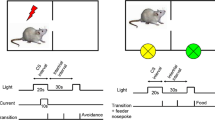Abstract
The present set of experiments examined the importance of the response initiation-inhibition parameter of certain avoidance conditioning tasks in the production of state-dependent dissociative effects with ethanol. On those tasks involving some degree of response inhibition (passive avoidance and two-way active avoidance), animals receiving ethanol during training were more impaired in their testing performance than those receiving saline during training (anterograde amnestic effect), and animals injected with ethanol during training and saline during testing displayed dissociation of their acquired avoidance behaviors during testing (asymmetrical dissociation effect). On the task involving a response initiation element with little contamination by response suppression factors (one-way active avoidance), dissociation of avoidance behavior during testing was found both for the animals trained under ethanol and tested under saline and for the animals trained under saline and tested under ethanol (symmetrical dissociation effect). The results were discussed in terms of possible joint effects of symmetrical state-dependency and other behavioral properties of the drug. However, an alternative interpretation could not be ruled out, namely that the mechanisms involved in the impairment found on the testing day for the drug-placebo and placebo-drug groups may be different. It was suggested that the drug-placebo group may represent the more general example of state-dependent dissociation effects, whereas the production of state-dependent dissociation effects in the placebo-drug group may depend upon the type of behavior conditioned and/or the strength of such conditioning.
Similar content being viewed by others
References
Barnhart, S. S., Abbott, D. W.: Dissociation of learning and meprobamate. Psychol. Rep. 20, 520–522 (1967).
Barry, H., III: Prolonged measurements of discrimination between alcohol and non-drug states. J. comp. physiol. Psychol. 65, 349–352 (1968).
—, Wagner, A., Miller, N.: Effects of alcohol and amobarbital on performance inhibited by experimental extinction. J. physiol. Psychol. 55, 464–468 (1962).
Baum, N.: An automated apparatus for the avoidance training of rats. Psychol. Rep. 16, 1205–1211 (1965).
Berger, B. D., Stein, L.: An analysis of the learning deficits produced by scopolamine. Psychopharmacologia (Berl.) 14, 271–283 (1969a).
— —: Asymmetrical dissociation of learning between scopolamine and Wy4036, a new benzodiazepine tranquilizer. Psychopharmacologia (Berl.) 14, 351–358 (1969b).
Bindra, D., Nyman, K., Wise, J.: Barbiturate-induced dissociation of acquisition and extinction: Role of movement-initiating processes. J. comp. physiol. Psychol. 60, 223–228 (1965).
Bindra, D., Reichert, H.: Dissociation of movement initiation without dissociation of response choice. Psychonom. Sci. 4, 95–96 (1966).
— —: The nature of dissociation: Effects of transition between normal and barbiturate induced states on reversal learning and habituation. Psychopharmacologia (Berl.) 10, 330–344 (1967).
Crow, L. T.: Effects of alcohol on conditioned avoidance responding. Physiol. Behav. 1, 89–91 (1966).
Girden, E., Culler, E.: Conditioned responses in curarized striate muscle in dogs. J. comp. Psychol. 23, 261–274 (1937).
Gruber, R. P., Stone, G. C., Reed, D. R.: Scopolamine-induced anterograde amnesia. Int. J. Neuropharmacol. 6, 187–190 (1967).
Holloway, F. A., Vardiman, D. R.: Dose-response effects of ethanol on appetitive behaviors. Psychon. Sci. 24, 218–220 (1971).
Kubena, R. K., Barry, H., III: Generalization by rats of alcohol and atropine stimulus characteristics to other drugs. Psychopharmacologia (Berl.) 15, 196–206 (1969).
McCleary, R. A.: Response modulating functions of the limbic system: Initiation of suppression. In: Progress in psychology, Vol. 1, pp. 210–272. E. Stellar and J. M. Sprague, eds. New York: Academic Press 1966.
Meltzer, D., Merkler, N. L., Maxey, G. C.: Discrimination reversal under sodium pentobarbital. Psychonom. Sci. 5, 413–414 (1966).
Otis, L. S.: Dissociation and recovery of a response learned under the influence of chlorpromazine or saline. Science 143, 1347–1348 (1964).
Overton, D. A.: State dependent learning produced by depressant -and atropine-like drugs. Psychopharmacologia (Berl.) 10, 6–31 (1966).
—: Dissociated learning in drug states (State dependent learning). In: Psychopharmacology, A review of progress 1957–1967, pp. 918–930. D. H. Efron, ed. Washington: American College of Neuropharmacology and Psychopharmacological Research Branch of National Institutes of Mental Health 1968.
—: State dependent learning produced by alcohol and its relevance to alcoholism. In: The biology of alcoholism, Vol. II: Physiology and behavior. B. Kissen and H. Begleiter, eds. New York: Plenum Press 1972.
Sachs, E.: Dissociation of learning in rats and its similarities to dissociative states in man. In: Comparative psychopathology: Animal and human, pp. 249–304. J. Zubin and H. F. Hunt, eds. New York: Grune & Stratton 1967.
—, Weingarten, M., Klein, N. W.: Effects of chlordiazepoxide on the acquisition of avoidance learning and its transfer to the normal state or other conditions. Psychopharmacologia (Berl.) 9, 17–30 (1966).
Schneider, A. M., Kapp, B., Aron, C., Jarvik, M.: Retroactive effects of transcorneal and transpinnate ECS on step-through latencies of mice and rats. J. comp. physiol. Psychol. 69, 506–509 (1969).
Stark, L. G.: An evaluation of scopolamine hydrobromide in the production of state dependent, one trial learning. Proc. Western Pharmacol. Soc. 10, 90–91 (1967).
Taber, R. I., Latranyi, M. B., Steiner, S. S.: Prevention of extinction of an active avoidance response by anti-anxiety agents. Paper presented at American Association of Pharmacology and Experimental Therapeutics (1967).
Wallgren, H., Savolainen, S.: The effect of ethyl alcohol on a conditioned avoidance response in rats. Acta pharmacol. (Kbh.) 19, 59–67 (1962).
Author information
Authors and Affiliations
Additional information
This investigation was supported in part by Public Health Service Grant 14702 from the National Institute of Mental Health.
The author wishes to acknowledge the careful work of his research assistant, Mr. Richard A. Wansley.
Special appreciation is given to Dr. Harold L. Williams for his critical reading of the manuscript.
Rights and permissions
About this article
Cite this article
Holloway, F.A. State-dependent effects of ethanol on active and passive avoidance learning. Psychopharmacologia 25, 238–261 (1972). https://doi.org/10.1007/BF00422505
Received:
Revised:
Issue Date:
DOI: https://doi.org/10.1007/BF00422505



